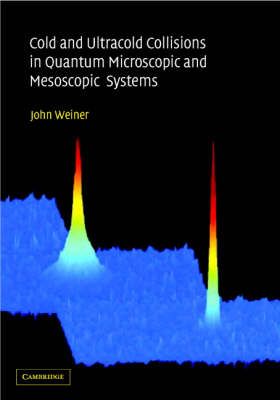
Cold and Ultracold Collisions in Quantum Microscopic and Mesoscopic Systems
Seiten
2003
Cambridge University Press (Verlag)
978-0-521-78121-3 (ISBN)
Cambridge University Press (Verlag)
978-0-521-78121-3 (ISBN)
This book describes collisions between atoms that have been cooled to extremely low temperatures by optical and evaporative cooling techniques. It reviews quantum theory of scattering, and summarizes techniques of optical cooling and trapping. It describes applications to precision spectroscopy, determination of atomic properties and the manipulation of Bose–Einstein condensates.
Cold and ultracold collisions occupy a strategic position at the intersection of several powerful themes of current research in chemical physics, in atomic, molecular and optical physics, and even in condensed matter. The nature of these collisions has important consequences for optical manipulation of inelastic and reactive processes, precision measurement of molecular and atomic properties, matter-wave coherences and quantum-statistical condensates of dilute, weakly interacting atoms. This crucial position explains the wide interest and explosive growth of the field since its inception in 1987. The author reviews elements of the quantum theory of scattering theory, collisions taking place in the presence of one or more light fields, and collisions in the dark, below the photon recoil limit imposed by the presence of any light field. Finally, it reviews the essential properties of these mesoscopic quantum systems and describes the key importance of the scattering length to condensate stability.
Cold and ultracold collisions occupy a strategic position at the intersection of several powerful themes of current research in chemical physics, in atomic, molecular and optical physics, and even in condensed matter. The nature of these collisions has important consequences for optical manipulation of inelastic and reactive processes, precision measurement of molecular and atomic properties, matter-wave coherences and quantum-statistical condensates of dilute, weakly interacting atoms. This crucial position explains the wide interest and explosive growth of the field since its inception in 1987. The author reviews elements of the quantum theory of scattering theory, collisions taking place in the presence of one or more light fields, and collisions in the dark, below the photon recoil limit imposed by the presence of any light field. Finally, it reviews the essential properties of these mesoscopic quantum systems and describes the key importance of the scattering length to condensate stability.
Preface; 1. General introduction; 2. Introduction to cold collision theory; 3. Experimental methods of cold collisions; 4. Inelastic exoergic collisions in MOTS; 5. Photoassociation spectroscopy; 6. Optical shielding and suppression; 7. Ground-state collisions; References; Index.
| Erscheint lt. Verlag | 4.12.2003 |
|---|---|
| Zusatzinfo | 4 Tables, unspecified; 113 Line drawings, unspecified |
| Verlagsort | Cambridge |
| Sprache | englisch |
| Maße | 180 x 256 mm |
| Gewicht | 570 g |
| Themenwelt | Naturwissenschaften ► Physik / Astronomie ► Atom- / Kern- / Molekularphysik |
| Naturwissenschaften ► Physik / Astronomie ► Festkörperphysik | |
| Naturwissenschaften ► Physik / Astronomie ► Optik | |
| Naturwissenschaften ► Physik / Astronomie ► Thermodynamik | |
| ISBN-10 | 0-521-78121-3 / 0521781213 |
| ISBN-13 | 978-0-521-78121-3 / 9780521781213 |
| Zustand | Neuware |
| Haben Sie eine Frage zum Produkt? |
Mehr entdecken
aus dem Bereich
aus dem Bereich
Buch | Softcover (2024)
Wiley-VCH (Verlag)
CHF 83,85


